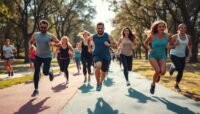In the world of sports, every moment matters. Fitness and conditioning are top priorities for athletes. They constantly search for the best training methods to boost their performance.
We will look at the key parts of sports training. We’ll see how cardio, strength, and flexibility work not just improves performance, but also helps prevent injuries. The use of science in training helps create programs that are just right for athletes in all sports.
Key Takeaways
- Fitness and conditioning are vital for improving sports performance.
- Incorporating various training modalities enhances overall athletic effectiveness.
- Strong cardiovascular health supports endurance in competition.
- Flexibility training is crucial for injury prevention.
- The science of sports conditioning guides tailored training programs.
- Effective conditioning prepares athletes for peak performance.
Understanding Sports Performance
Being fit matters a lot in sports. Athletes need to be good at several physical skills to do well. They need strengths like endurance, flexibility, and quick moves. All these help them perform better.
The Role of Physical Fitness in Sports
For better sports results, athletes follow specific exercise principles. These principles help create training plans that fit the sport. They learn how different workouts help different parts of the body.
An effective training program touches on all key parts of fitness. This includes:
- Aerobic Capacity: Being able to last through long activities is key.
- Muscle Strength: Strong muscles lead to better performance in competitions.
- Flexibility: Being more flexible helps with moving smoothly.
- Agility: Being quick and precise matters in many sports.
Information from trusted places like the American College of Sports Medicine shows why it’s important to train these areas. Athletes who make fitness a priority both boost their performances and lower injury risks.
Components of Fitness for Athletes
For athletes aiming to boost their game, knowing about fitness is key. It helps create training plans that match the sport’s needs. Strength, endurance, and flexibility are crucial. They are big in training, keeping you fit, and stopping injuries.
Strength
Strength is vital for power in sports. It comes from exercises that build muscles. Like weightlifting, resistance moves, and workouts using your body weight.
Try doing squats, deadlifts, and bench presses. They work several muscles at once. This not only ups your game but also keeps injuries away. It does this by making joints stable and improving how you move.
Endurance
Endurance is key for events that last a long time. Doing aerobic exercises like running, biking, and swimming boosts heart fitness and stamina. Adding interval training can also help a lot.
This kind of training increases your ability to keep going in long competitions. It’s all about staying strong from start to finish.
Flexibility
Being flexible helps avoid injuries and do better in sports. Start with dynamic stretches to get muscles and joints ready. Add mobility exercises to training to increase movement and lower strain risks.
Staying committed to flexibility training means you can do your best. And it means less chance of getting hurt.
The Science of Conditioning
Learning how to condition athletes properly boosts their performance. The key ideas are periodization and specificity. These methods improve training by making it fit the athlete’s needs.
Periodization
Periodization is about planning training to peak at the right time. It creates a structured way to progress, focusing on different levels of intensity. For example, training is divided into macrocycles, mesocycles, and microcycles, each with specific goals.
| Cycle Type | Duration | Focus |
|---|---|---|
| Macrocycle | 1 year | Overall performance enhancement |
| Mesocycle | 2-6 weeks | Specific training objectives |
| Microcycle | 1 week | Weekly training sessions |
Specificity
The specificity principle means training should match the sport’s demands. Programs must be designed for the physical needs of each sport. This approach sharpens the athlete’s skills and strengthens the needed muscles for competition.
Using these exercise principles helps athletes reach their top performance. This is crucial for success in competitions.
Injury Prevention in Sports Conditioning
Injuries often set back athletes in their sports. A well-designed conditioning program is key to preventing injuries. This part talks about common sports injuries and how to lower injury risks. These steps help athletes give their best performance.
Common Sports Injuries
Some injuries are common among athletes and affect how well they do in sports. Knowing these common injuries helps in creating effective prevention plans. Frequent sports injuries include:
- Sprains
- Strains
- Tendinitis
- Stress fractures
- Concussions
Prevention Strategies
Using certain strategies can lower injury risks. Here are important methods athletes can add to their training:
- Proper Warm-Up: A good warm-up increases blood flow and gets muscles ready for action.
- Strength Training: Stronger muscles offer more stability and reduce injury chances.
- Recovery Techniques: Adequate rest and recovery methods, like physical therapy, help maintain performance.
- Flexibility Exercises: Stretching regularly improves flexibility and guards against strains and sprains.
Understanding common injuries and applying prevention tips can boost an athlete’s career. These practices lead to a healthier body and better sports performance.
| Injury Type | Common Causes | Prevention Strategies |
|---|---|---|
| Sprains | Twisting movements | Proper warm-up and strength training |
| Strains | Overstretching | Flexibility exercises and gradual progression |
| Tendinitis | Overuse | Regular recovery for muscle groups |
| Stress fractures | High-intensity training | Cross-training and adequate rest |
| Concussions | Impact to the head | Protective gear and awareness of techniques |
Nutrition for Performance Enhancement
Good sports nutrition is key to better athletic performance. Eating well for fitness helps athletes reach their dreams. Knowing about macronutrients, hydration, and when to eat helps a lot.
Macronutrient Balance
Athletes need the right mix of carbs, proteins, and fats. Carbs are the main energy for activities. Whole grains, fruits, and veggies are great for carbs. Proteins help fix and build muscles, found in lean meats and plants. Fats like nuts and avocados give energy for long efforts.
To get the best results, eat at the right times. Carbs are best before and after working out. Protein after exercise helps recovery and muscle building. A smart eating plan improves performance. Studies show these diet tips work for sports goals.
Hydration Strategies
Staying hydrated is vital. It stops tiredness and keeps muscles working well. Drink water and electrolyte drinks when working out a lot or in heavy training.
- Keep track of how much you sweat to know how much to drink.
- Drink fluids all the time – before, during, and after exercise.
- Using good hydration plans helps keep you going and avoids getting dehydrated.
Using these hydration and nutrition tips will boost health and performance. Following science-backed advice helps athletes in their sports journey.

The Mind-Body Connection in Sports
Sports psychology is key for better sports performance. It helps athletes understand how their minds can affect their bodies. This means becoming mentally prepared is as vital as being physically ready. Mental conditioning helps with focus and keeping emotions in check during competitions and practice.
Sports Psychology
Sports psychology looks at how thinking impacts performance. Studies find that being mentally tough helps prevent injuries and recover faster. Visualizing success can boost confidence and ease stress. Managing anxiety through deep breaths and mindfulness lets athletes give their best.
Mental Conditioning Techniques
Adding mental conditioning to training gives athletes an advantage. Here are key techniques:
- Visualization: Picture achieving goals to enhance motivation.
- Positive Self-Talk: Replace negative thoughts with affirmations to build confidence.
- Goal Setting: Establishing measurable, attainable goals can provide direction and purpose.
- Focus Techniques: Use concentration drills to sharpen mental acuity.
- Mindfulness Exercises: Practices that foster awareness can help with stress management.
Using these mental conditioning methods, athletes can get mentally ready. This leads to better sports performance and helps avoid injuries.
| Mental Conditioning Techniques | Description | Benefits |
|---|---|---|
| Visualization | Picturing success in competitions | Boosts confidence and focus |
| Positive Self-Talk | Encouraging internal dialogue | Reduces anxiety, enhances performance |
| Goal Setting | Establishing clear and achievable objectives | Provides direction, fosters motivation |
| Focus Techniques | Drills to maintain concentration | Improves performance under pressure |
| Mindfulness Exercises | Awareness practices to manage stress | Enhances mental clarity and relaxation |
Biomechanics in Sports Performance
Biomechanics is essential for improving sports performance. It helps athletes understand and enhance their movement patterns. This improves their performance and reduces injury chances. So, let’s explore the value of analyzing and refining movement for better performance.
Movement Analysis
Movement analysis helps coaches and athletes break down sports actions. They use tools like video analysis and motion capture for insights. These tools show details like angles and forces in movements. This way, they can make changes to boost performance and cut down injury risks.
Efficiency in Motion
Focusing on motion efficiency can boost an athlete’s performance. Athletes with strength and conditioning training can move more effectively. This not only enhances speed and agility but also helps with endurance. Biomechanical principles also prevent injuries, keeping athletes in the game longer.
| Biomechanics Aspect | Impact on Performance | Injury Prevention Benefits |
|---|---|---|
| Movement Analysis | Identifies mechanical inefficiencies | Reduces risk of overuse injuries |
| Strength and Conditioning | Enhances overall athletic capabilities | Increases durability against stress |
| Efficiency Techniques | Improves technique and skill | Lessens strain on muscles and joints |
Strength Training Modalities
Strength training is key for better sports performance. Athletes choose between free weights and machines based on their needs. Knowing how these options enhance strength helps athletes improve their training.
Free Weights vs. Machines
Free weights, like dumbbells and barbells, work many muscle groups. They need more balance, which boosts overall strength. On the other hand, machines guide movements for safer exercises, especially for newbies. The choice depends on personal goals and skill level. Here’s a quick look:
| Criteria | Free Weights | Machines |
|---|---|---|
| Muscle Engagement | Engages stabilizing muscles | Target specific muscles |
| Range of Motion | More natural movement patterns | Fixed path of motion |
| Skill Level Required | Requires proper form and technique | Often easier for beginners |
| Portability | Can be used anywhere | Generally stationary equipment |
Plyometrics and Olympic Lifts
Plyometrics and Olympic lifts boost explosive strength. They’re key for sports success. Plyometrics use fast-twitch muscles for quick moves. Olympic lifts, like the clean and jerk or snatch, mix strength with coordination. Together, they make training more effective.
Using different strength training methods leads to all-around growth. Check out this policy document for more on training optimization.
Aerobic and Anaerobic Conditioning Techniques
Aerobic and anaerobic conditioning matters a lot in sports. They help athletes train better and improve in sports. By mixing endurance exercises and high-intensity interval training (HIIT), people can get the best from their workouts.
Endurance Training
Endurance training boosts cardiovascular health. It helps athletes go further for longer. Here are some ways to do it:
- Steady-state cardio: This keeps your pace even for a long time, making your aerobic system stronger.
- Tempo runs: Mixing faster runs into your routine pushes your limits and improves endurance.
- Long-distance running: Longer runs help build the stamina needed for many sports.
High-Intensity Interval Training (HIIT)
HIIT is great for your anaerobic system, which boosts speed and power. The perks of HIIT include:
- Increased calorie burn: By switching between hard effort and rest, you burn more calories.
- Time efficiency: HIIT lets you get a lot done in less time, improving fitness fast.
- Versatile formats: There are many different HIIT workouts, keeping exercise exciting and tough.
Using both endurance and HIIT is a smart way to train. It targets different parts of fitness, making athletes stronger and more versatile. Following these methods correctly can really push sports performance to new levels.
| Technique | Type | Focus Area |
|---|---|---|
| Steady-state cardio | Aerobic | Endurance |
| Tempo runs | Aerobic | Threshold |
| HIIT | Anaerobic | Speed and Power |
| Long-distance running | Aerobic | Stamina |
The Importance of Recovery
Recovery is key to boosting sports performance and keeping healthy. It’s important to know different ways to recover to prevent injuries and perform well. Active recovery exercises, good sleep, and the right nutrition are vital for athletes to reach their goals.
Active Recovery Techniques
Active recovery means doing light exercises to ease muscle pain and improve blood flow. Some popular active recovery methods are:
- Light jogging or walking
- Stretching exercises
- Foam rolling for myofascial release
These techniques help lessen muscle tightness. They also speed up recovery, which is critical for ongoing sports performance.
Sleep and Recovery Nutrition
Good sleep is essential for fixing and growing muscles. Quality rest boosts endurance and brain functions important for sports. It’s important to match sleep times with training schedules. Nutrition also greatly affects recovery. Eating well helps fix muscles. Important foods and supplements for recovery are:
| Food/Supplement | Benefits |
|---|---|
| Lean proteins (chicken, fish) | Supports muscle repair and growth |
| Fruits (bananas, berries) | Provides antioxidants and vitamins |
| Whole grains (quinoa, brown rice) | Replenishes glycogen stores |
| Omega-3 supplements | Reduces inflammation and enhances recovery |
Athletes should focus on sleep and nutrition for recovery. This helps lower injury risks and boosts fitness and conditioning for sports.

Tailoring Conditioning Programs
Creating effective conditioning programs is all about understanding each athlete. It’s crucial to customize strength and conditioning programs. This ensures athletes get the most out of training and avoid injury. Every sport requires different physical skills, so training must be tailored accordingly.
Individualization Based on Sport
Different sports need different physical skills. A sprinter needs explosive power, while a marathon runner needs endurance. By individualizing conditioning programs, athletes train in ways that suit their sport. This targeted training boosts performance and helps prevent injuries.
Age and Skill Level Considerations
Youth athletes need careful attention due to their growing bodies. Planning their strength and conditioning is key to preventing injuries and ensuring success. Coaches should tailor training to the athlete’s age and skill level. This approach makes training safe and effective, helping athletes grow and improve.
| Sport | Main Focus | Key Conditioning Element |
|---|---|---|
| Soccer | Endurance | Aerobic capacity |
| Football | Power | Strength training and explosive movements |
| Basketball | Agility | Speed and coordination drills |
| Baseball | Strength | Core strength and rotational power |
| Track & Field | Speed and Technique | Specific skill drills and sprints |
Advances in Technology for Training
In recent years, tech has greatly changed the way athletes train and improve. Wearable gadgets and advanced video tools lead this change. They help athletes understand their training and movement better.
Wearable Devices and Metrics
Wearable tech like smartwatches track important health stats. They monitor heart rate, activity, and how well you recover. This information helps tailor training to fit each athlete’s needs. It also helps avoid injuries. Brands like Garmin and Polar are favorites for their training-friendly designs.
Video Analysis
Video tools are changing the way athletes look at their techniques. They use slow-motion cameras to study their moves during training or contests. This helps spot and fix errors, leading to smoother movements. Companies like Hudl and Dartfish make it easier for coaches and players to work together on these improvements.
Considerations for Women in Sports Conditioning
Women who train for sports face special physical challenges. These challenges can affect their training and how well they perform. It’s very important to understand these issues to make training better for female athletes. This means looking at things like hormone changes and body composition. These factors need special plans to help women perform their best and recover well.
Unique Physiological Needs
Women’s bodies react to training differently because of their hormone levels. Hormones like estrogen and progesterone can change energy, muscle repair, and how the body uses fat. These differences mean women need training programs that fit these changes. When these needs are met, female athletes can do their best while staying healthy.
Injury Risk and Prevention
Female athletes might get hurt more easily, with common injuries being ACL tears and stress fractures. These issues often come from how women’s bodies are built, like the way knees and hips are aligned. It’s very important to focus on preventing these injuries. By doing exercises that improve how they move and increase stability, women can lower their risk of getting hurt. This helps them stay active and competitive.
Building a Support Network for Athletes
Building a strong support network is key for athletes. Coaches and trainers are vital, not just for training, but also for preventing injuries. They give athletes the tools needed to succeed in body and mind.
The Role of Coaches and Trainers
Coaches and trainers are like mentors. They help athletes overcome performance hurdles and grow personally. They impact more than physical training, touching on sports psychology to boost mental strength.
They set up training plans and offer advice for competing and healing. This kind of support boosts motivation and lowers stress.
Family and Community Support
Support from family and community is crucial for success. Families provide love and a feeling of security, making athletes stronger. Community groups, like local sports clubs, add to this sense of belonging.
They offer encouragement, positive vibes, and resources, fueling athletes’ dedication and ambition.
A strong support network truly matters for athletes. It affects their performance, mental well-being, and overall success. Having a supportive team, both in their professional and personal lives, helps athletes reach their dreams.
Conclusion: Enhancing Performance Through Holistic Conditioning
Today’s athletes need a full grasp of fitness and sports conditioning to compete. They must blend physical training, nutrition, mental conditioning, and recovery. This approach boosts performance and helps avoid injuries.
A complete training program boosts not just physical ability but also mental and emotional health. It leads to better teamwork and stronger bonds among athletes. Research shows the benefits of such training go beyond just physical skills. They promote overall personal growth.
Athletes and coaches must always look for new knowledge and embrace cutting-edge techniques to stay ahead. It’s crucial to understand how different training methods prevent injuries and lead to success. This informative article offers great insights. The field of sports conditioning is always evolving, pushing everyone in it to keep learning and adapting.
FAQ
What is the importance of fitness and conditioning for sports?
Fitness and conditioning are key for boosting athletic skills. They include strength training, cardio, and flexibility exercises. This mix enhances an athlete’s abilities and helps dodge injuries.
How can sports performance be improved through conditioning?
Conditioning programs tailored to the athlete can lift sports performance. They work on exercise science, muscle power, and stamina. This ensures the training meets the sport’s specific needs.
What role does nutrition play in sports conditioning?
Nutrition is vital for improving performance. Eating the right balance of carbs, proteins, and fats, and staying hydrated boosts energy and recovery. This support helps athletes do their best.
How can athletes prevent injuries during training?
To prevent injuries, athletes should warm up properly and include strength training. They should also focus on recovery practices. Knowing about biomechanics and common injuries helps keep risks low.
What is the significance of mental conditioning in sports?
Mental conditioning is crucial for athletes. Techniques like visualization and positive talk boost mental toughness. This leads to better performance and helps manage stress and anxiety, especially after injuries.
How does strength training impact athletic performance?
Strength training boosts athletic performance by building explosive power and overall strength. It also helps prevent injuries. Athletes should add exercises like free weights and plyometrics to their routines.
What are effective recovery strategies for athletes?
Good recovery strategies include gentle exercises, enough sleep, and proper nutrition. These steps help repair tissues and muscles. They keep athletes ready and prevent overtraining.
How do advances in technology influence athletic training?
Technology like wearable devices and video analysis changes how athletes train. It gives data on heart rate, movements, and mechanics. This allows for training based on solid information, improving results.













Leave a comment